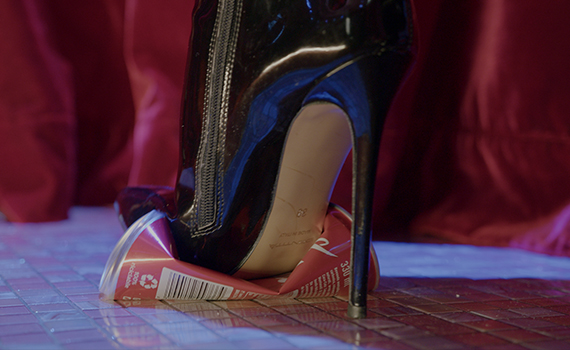Eleonora Roaro, “Irma Vep”
Single-channel video | 5’54’’
3840 × 2160 UHD 16:9 | Silent
Edition 3 + AP | 2023
Camera and DOP: Marco Brianza
Costume: Francesca Mulè
Eleonora Roaro, “@irmavep_nowhere”
IoT sculpture (3D printing in PLA, microcontroller Arduino, pink LED strip)
23x8x25 cm | edition 3 + 2 PA | 2023
NeRF scanning and 3D model optimization: Alessandro Passoni
3D printing + IoT: Marco Brianza
Eleonora Roaro, “Irma’s Heels”
Instagram filter | 2023
3D model: Alessandro Passoni
In memory of Orio Vergani / Nowhere gallery.
“People took the silence of the movies for granted because they never quite lost the feeling that what they saw was after all only pictures.”
Rufolf Arnheim, Film as Art
(University of California Press, 1957), p. 33.
Irma Vep is one of the earliest femme fatales – or vamps, a contraction of vampire, of which the name Irma Vep is an anagram – in the history of cinema. Portrayed by the actress Musidora, she is a cat suit-wearing burglar in the silent crime serial film “Les Vampires” (1915) written and directed by Louis Feuillade. She initially inspired the surrealists and later filmmakers such as Olivier Assayas, who created a film (1996) and then a TV series (2022) titled “Irma Vep.” Both of these works are metanarrative pieces that attempt to reenact the original serial, with the actress, in the first case, wearing a black vinyl catsuit purchased from a sex shop.
Irma Vep is an alter ego of the artist Eleonora Roaro, based on interviews with professional dorminatrices (“pro dommes” for short) active between Milan and Turin. She is a collective character that allows a reflection on sex work, fetishism, desire, and images in contemporary society, in an “onlife” dimension where the boundaries between online and offline are increasingly blurred. With her latex catsuit and glossy boots, Irma Vep is a virtual image that embodies fetishistic and sadomasochistic (SM) impulses. As Arnheim wrote a few years after the invention of sound films, in silent cinema – which operates exclusively through images – sight is the main sense. Therefore, silent film offers the opportunity to explore the connection between images and fetishism, as well as fetishism for images. “The fetish would be entirely like a symbol, but similar to an impressed and fixed plane, an impressed image, a photograph to which one would always return.”
Irma Vep is a performance that allows us to consider SM practices as a cultural performance: they stage power dynamics that can simultaneously draw from and disavow their social referents. Sexual relationships, much like political relationships, are perceived as power struggles, with the peculiarity that, in the case of SM, these positions are interchangeable, as gender roles are.
Irma Vep is an exhibition composed of three works: a video (“Irma Vep”), in which the narrative is conveyed through text as in the intertitles of the silent era; an IoT sculpture titled “@irmavep_nowhere”, a 3D printed replica of the boot worn in the video, that lights up in pink when users and Irma Vep – within the ambiguity of whether she is a physical person or a bot – interact with each other on Telegram; and an Instagram filter (“Irma’s Heels”) that allows the shiny 3D boot model to be placed anywhere in the world.
